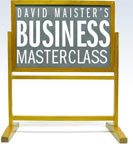

TITLE | TIME |
Adapting to the Future – Whatever It Is… | (17:42) |
How do you ensure that your firm is good at identifying emerging needs, examining them and devising responses? A set of managerial processes is described to ensure that an professional business can evolve along with its marketplace.
RELATED RESOURCES:
NOTES FOR THE EPISODE:
Timeline:
00:48 —
The strategic challenge for professional businesses is not to forecast the future, but to ensure that the company is effective at adapting or responding to (already observable) market changes, whatever they may be.
Consider, for example, this list of trends in the profession(s):
- Fee pressure on “mature” services
- Greater mobility of senior officers and junior professionals
- Continued client (or customer) demand for high specialization
- Increasing client (or customer) demand for counseling skills and for greater technical expertise
- Competition for staff from other professions/industries (change in perceived “glamour”)
- Rising diversification of services inside companies – need to manage different businesses differently
- More need for investment in Technology, R&D, Marketing
- More client (or customer) demand for specific industry expertise
- Globalization of the marketplace
- Growth of computer technology
- Rising (and shifting) training needs
- Cultural shift in work-ethic among junior professionals
07:12 —
What would characterize a responsive, adaptive, flexible organization? The company would need to be better than the competition (at a minimum) in most of the following things :
- Aggressive Listening to the Market (…)
- 08:20 —
Using Market Intelligence (…)
- 09:38 —
Raising the Level of Innovation (…)
- 11:14 —
Sharing New Knowledge (…)
- 12:49 —
Pressure for Personal Growth (…)
- 13:47 —
Management Behavior (…)
- 14:45 —
Measuring Success (…)
15:13 —
Try these discussion questions at one of your next (small-scale) professionals’ meetings:
- Why have we not responded in the past as well as we could have to environmental trends that we knew about? What has held us back? What have the barriers to change been?
- How good are we at listening to our markets in a systematic fashion? What program can we devise to ensure that our different markets tell us what they want and need? What would they like us to change?
- How can we stimulate more experimentation? How can we get more people seeking out innovations? How can we pilot test more new ideas?
- How can we promote the sharing of new approaches? How do we ensure that lessons learned in one place are pooled, analyzed, adapted and disseminated? How do we ensure that what we learn is spread rapidly through the organization? How do we encourage contribution of ideas?
- How can we encourage all company members to strive for personal growth? How do we pay more attention to “growing our assets” as well as to our short-term financials?
- What is the role of management in creating the organization that seeks out change? What should they do to encourage it? What do they have to do to stop discouraging it?
16:40 —
This concludes ADAPTING TO THE FUTURE: WHATEVER IT IS the 9th episode in my series, Strategy in Professional Businesses

















